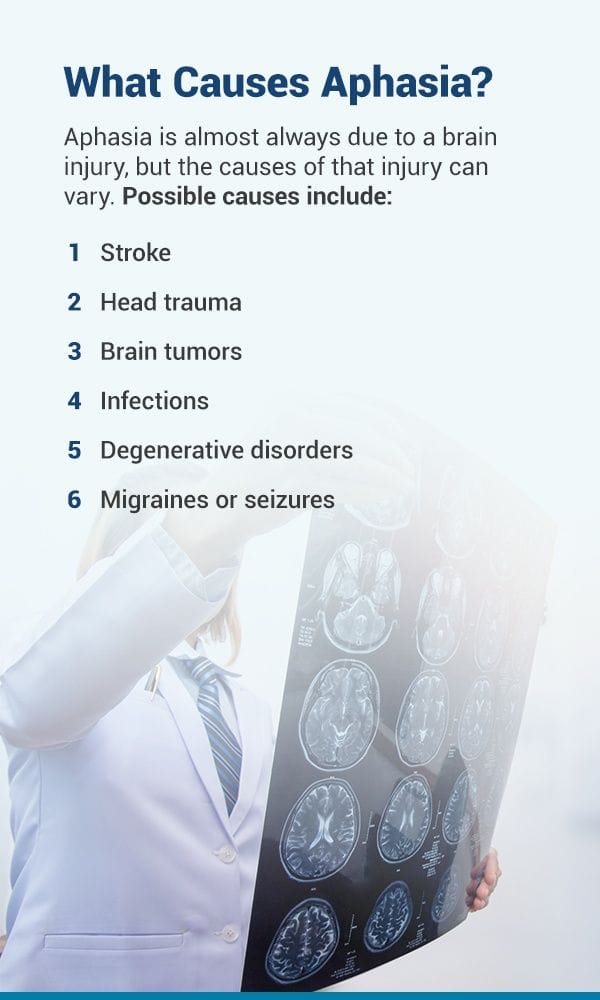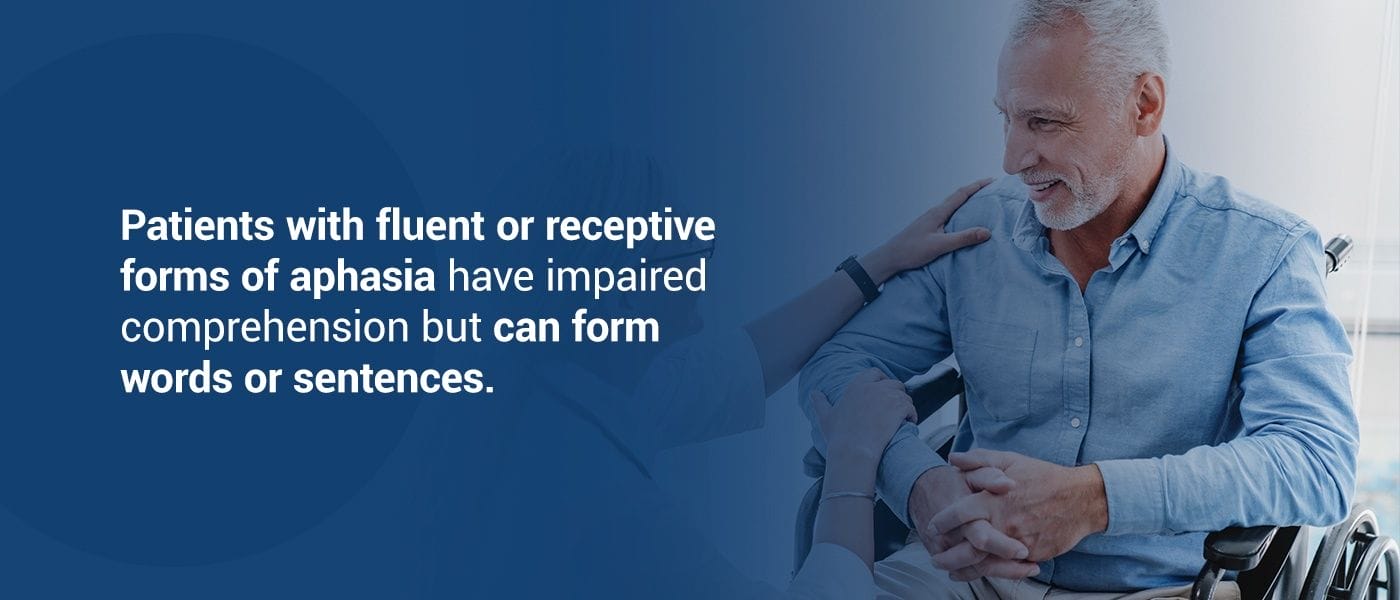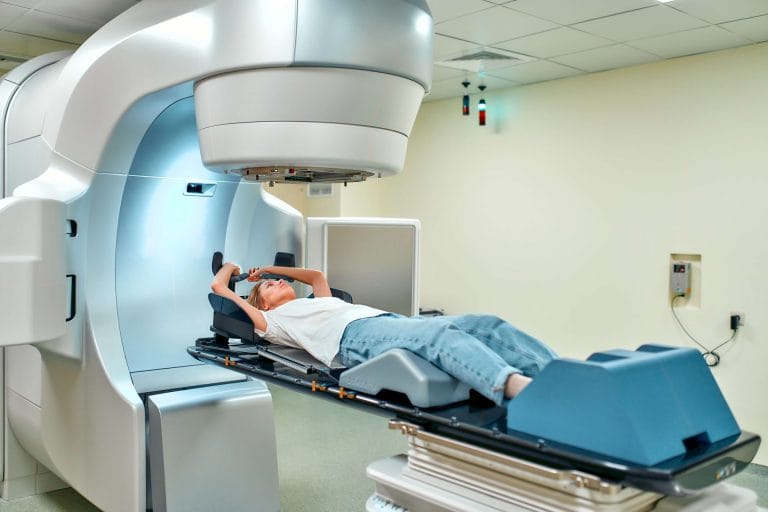After suffering a brain injury, many find difficulty communicating with others. They may struggle to form sounds, understand what others are saying, recall specific words or form comprehensible sentences. They might also struggle to read or write. This disorder is aphasia, and it can take many different forms. It most often appears after a stroke, but it can result from other brain injuries, too.
Explore Stroke Rehabilitation Programs Offered by PAM Health
Aphasia can be a debilitating issue, limiting the patient’s ability to communicate with others. This condition affects all areas of someone’s life, including personal relationships and professional opportunities. If someone in your life has an aphasia diagnosis, it is important to understand the disorder — its definition, causes, variations and most effective treatments. Understanding aphasia will help you work together to overcome it.

What Is the Definition of Aphasia?
Aphasia is a language impairment, which affects someone’s ability to produce or comprehend language through speech or writing. A patient may lose speech fluidity, the ability to understand speech or the ability to repeat words or phrases. They may also have reading or writing issues. Aphasia’s impact varies between individuals, depending on the cause’s severity. In most cases, it affects multiple aspects of communication.
Aphasia can be temporary or permanent. Often, symptoms peak right after a brain injury. With proper treatment, side effects may decrease and communication skills can improve. Though learning to communicate through aphasia can be frustrating, many patients live full lives. Overcoming aphasia takes patience, consistent effort and the right strategies.

What Causes Aphasia?
Aphasia is almost always due to a brain injury, but the causes of that injury can vary. Anything that affects language production or comprehension areas of the brain can lead to aphasia. Possible causes include:
- Stroke: Strokes are the most common cause of aphasia. Strokes are also the fifth leading cause of death in the United States and often result in long-term disability. Each year, 750,000 strokes occur in the United States — about a third of those cause aphasia. The connection between aphasia and stroke is more widespread than many realize.
- Head trauma: Injury-related trauma can damage areas of the brain important for speech and language. Traumatic brain injuries can be short- or long-term, depending on their severity. If a traumatic brain injury causes aphasia, it will likely cause other cognitive problems, as well. Though trauma is a less common cause than stroke, aphasia and head injury often go hand-in-hand.
- Brain tumors: Because tumors are masses of growing cells, a brain tumor can harm the brain’s language centers. Resolving aphasia will depend on the cancer treatment’s success, though some people may experience long-term communication issues. With slow-growing tumors, the brain may be able to shift language processing to another area — the brain has remarkable adaptability.
- Infections: In some cases, an infection may cause aphasia, though this is less common. Those with compromised immune systems are much likelier to have brain infections. An infection can lead to additional cognitive issues.
- Degenerative disorders: Degenerative disorders including Alzheimer’s disease may cause aphasia-like symptoms in language processing and communication.
- Migraines or seizures: Aphasia brought on by a migraine or seizure is temporary, lasting only during the episode.
What Are the Different Types of Aphasia?
Aphasia comes in many different forms, all with unique symptoms. Patients often preserve all other cognitive abilities beyond speech and language processing. The type and severity of aphasia present will affect rehabilitation and treatment. To understand the different types of aphasia, it is important to know how the brain’s language processing and production work.
Language Centers of the Brain
Different types of aphasia affect different language-related areas of the brain. When trying to understand the disorder, it is helpful to comprehend the brain’s language centers. The most important ones are the Broca’s and Wernicke’s areas. The Broca’s area is a region in the frontal lobe of the dominant hemisphere, responsible for language production. The Wernicke’s area is a region in the temporal lobe of the brain’s left side, responsible for language comprehension.
Damage to the Broca’s area impairs production ability, while damage to the Wernicke’s area impairs comprehension. For that reason, the different types of aphasia fit into two major categories: fluent or receptive and non-fluent or expressive. When diagnosing aphasia, the doctor will determine whether the main issue is with understanding or expressing language.
Non-Fluent or Expressive Forms of Aphasia
A patient with non-fluent or expressive aphasia might retain comprehension but has difficulty finding or forming words. The patient knows what they want to say but has difficulty expressing it to others through verbal or written communication. Non-fluent forms of aphasia include global, mixed transcortical, Broca’s and transcortical motor aphasia:
1. Global
Global aphasia is the most severe form of the disorder. It is both receptive and expressive, impacting the person’s language input and output. A patient has global aphasia if they struggle with forming any recognizable words and comprehending and repeating speech. They will also struggle with reading and writing. This condition is likely temporary and is at its most severe right after the brain injury. With treatment, global aphasia can fade into a less severe diagnosis. If the brain damage is extensive, global aphasia may be longer-lasting.
Abilities vary across cases, but some patients with global aphasia can answer basic “yes or no” questions. They may also be able to say automatic phrases like “excuse me” or “thank you.” They struggle with all forms of communication, including speaking, understanding others, reading and writing. As this is the most severe form of the disorder, it can damage the patient’s relationships, professional career and social life. The lack of relationships can lead to feelings of isolation or depression, but intensive communication therapy can help reduce depression.
2. Mixed Transcortical
Also called mixed non-fluent aphasia, mixed transcortical aphasia describes patients who can produce sparse speech with great effort. They also have limited comprehension and struggle to read or write. They struggle least with repetition skills — they can repeat words or phrases in most cases. This version of the condition involves damage near the Broca’s and Wernicke’s areas, the brain’s language production and comprehension centers. The damage is indirect, separating language skills from other parts of the brain.
The exact opposite of mixed transcortical aphasia is conduction aphasia — patients have intact language comprehension and production but struggle with repetition. You can read more about conduction aphasia below.
3. Broca’s
Those with Broca’s aphasia, another non-fluent form, have limited access to vocabulary and sound formation, including repetition. What differentiates mixed transcortical and Broca’s aphasia is that Broca’s aphasia patients have higher levels of comprehension. Despite improved comprehension, they may struggle to understand complex sentence structures.
Broca’s aphasia gets its name from French Scientist Paul Broca, who connected these language production deficits with an area of the frontal lobe of the dominant hemisphere — the Broca’s area. This part of the brain regulates the breathing patterns and vocalizations needed for speech.
4. Transcortical Motor
Transcortical motor aphasia involves difficulty speaking or writing but has less impact on comprehension. It is similar to Broca’s aphasia — the key difference is repetition ability. Those with transcortical motor aphasia can often repeat speech. This form of aphasia may represent the recovery phase from Broca’s aphasia.
The main difficulty is with finding the right words or creating complex sentence structures when speaking or writing. An individual may feel the right word is often “on the tip of the tongue.” Their grammar may suffer as they miss articles or prepositions, focusing on key nouns and verbs. A stutter might be present.

Fluent or Receptive Forms of Aphasia
Patients with fluent or receptive forms of aphasia have impaired comprehension but can form words or sentences. They may be able to speak in sentences that mimic normal speech but use incorrect sounds or words or struggle to recall specific words. Often, they are unaware of their speech defects. Fluent forms of aphasia include Wernicke’s, transcortical sensory, conduction and anomic:
1. Wernicke’s
Since Wernicke’s aphasia is a fluent form, producing words is not the main concern. Patients can still form sentences. However, they may not be able to grasp words’ meanings. Though speech is fluent, it is abnormal and often nonsensical. Without realizing it, the patient might include irrelevant or non-existent words in their sentences. Since they think they are making sense, they may be confused when others do not understand them. When listening to a Wernicke’s aphasia patient speak, you may notice:
- Words strung together in nonsense sentences.
- Made-up words with no meaning.
- Voice inflection as you would find with regular speech.
- Well-articulated words.
- Quick speaking.
- Difficulty with repetition.
- Understanding visual cues better than written or spoken words.
This type of aphasia involves damage to the left posterior temporal region of the brain, which is part of the Wernick’s Area. This part of the brain gets its name from German neurologist Carl Wernicke, who identified this speech deficit.
2. Transcortical Sensory
Transcortical sensory aphasia is another form of fluent aphasia. Those who have it can repeat long, complex sentences but struggle with comprehending speech. It is one of the less common forms of aphasia. Since patients may be unaware of their impairment, they can be mistakenly diagnosed with a psychological disorder like schizophrenia.
3. Conduction
As a rare form of aphasia in which expression and comprehension remain intact, conduction aphasia involves an inability to repeat words or phrases. The patient can speak without much trouble and they retain comprehension. Only repetition is damaged. The patient may be able to articulate a similar response but not repeat the same word or phrase they hear.
This unusual condition may be caused by an impaired connection between the Broca’s and Wernicke’s areas — the link between auditory processing and verbal output. In most cases, a patient with this condition can carry on normal life activities. With practice, an individual may improve repetition.
4. Anomic
Anomic aphasia is a mild form of the disorder, though it can still cause frustration. Patients can comprehend language and speak with fluency but feel a persistent sense of “tip-of-the-tongue” syndrome. They struggle to find the right words to describe their thoughts, often using vague words like “thing” or trying to describe words in roundabout ways.
For instance, as the patient struggles to recall the word “tongs,” they may say, “the thing you use to pick things up.” In some cases, the speech may come across slow or halting as the individual struggles to identify the right word.
The title “anomic” means “without names” — anomic patients can describe thoughts with complete sentences and high levels of detail while groping for certain words. They struggle most in recalling specific nouns and verbs. Trouble finding the right words appears in writing and speech. Like those with conduction aphasia, these individuals can carry on with normal life activities.
What Are Aphasia Treatments?
Sometimes aphasia will fade on its own without treatment, but in most cases, speech and language therapy is necessary. A professional speech and language therapist will help the patient restore communication.
Speech and Language Therapy
A speech and language therapist caring for an aphasia patient will work toward certain goals, which may include:
- Reducing impairment: The therapist helps the patient restore as much of their speech and language as possible. This process takes practice and patience. With non-fluent aphasia, the patient will have to practice forming sounds and words. With fluent aphasia, they will work on defining and recalling words.
- Helping the patient communicate: The therapist will try to engage the patient as much as possible, encouraging participation. They will help find means for conveying thoughts.
- Finding alternatives: Alternative forms of communication can be helpful. Strategies might include using maps or other visual aids or providing the first letter of a target word.
- Providing information: During and beyond treatment, the therapist will provide helpful information to the patient and their loved ones.
Benefits of Speech and Language Therapy
Speech and language therapy has many advantages for the patient and their family, including:
- Improving the individual’s confidence.
- Lessening feelings of isolation and frustration.
- Giving the patient and their family strategies for communication.
- Providing alternatives to assist in communication.
- Helping reduce symptoms for long-term impact.
Find a PAM Health Location for Stroke Rehabilitation Programs
Stroke-induced aphasia can cause hurdles and frustration for the patient and their loved ones. Strokes can cause many debilitating issues beyond speech and language concerns, including difficulty walking, balancing or swallowing. After suffering a stroke, most patients need comprehensive rehabilitation. If you are looking for a stroke rehabilitation program, consider PAM Health.
At PAM Health, our caring and friendly staff helps patients restore their previous quality of life. We offer inpatient care, involving individualized treatment plans, physician evaluations, clinician-administered therapy, community access and educational sessions. After inpatient treatment, patients have access to continued outpatient services, including therapy and support groups.
Find a PAM Health Location Near You



